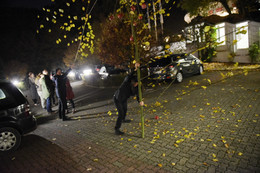
Farewell
Performance at BLOW!-Visiting Artist 2 curated by Helge Meyer, Bad Salzdetfurth, Germany, 2016
With support from the Arts Promotion Centre Finland TAIKE (artist grant for year 2016)
Text by Helge Meyer. Translation by Felix Scharr. Photography by Nilz Böhme
A hotel corridor. Functional and brightly lit. In the hallway, we are facing our own reflection in the panes… with darkness right behind. A man arranges objects on a dimly lit parking area, transforming it into a site of departure, arrival and the in-between. A giant branch appears as a foreign body on the functional space. Nature descends upon this place of brief hesitation. Suitcases stand around, a luggage trolley is located in one corner of the space. Szrama starts to dissect the enormous branch. The atmosphere becomes more hectic, things happen simultaneously. The audience becomes more and more involved: A child is lifted onto the shoulders of a man and another audience member continuously brings hands full of foliage, which the child takes and lets it fall onto the ground. Other audience members cut peppers and yet others roll around on the luggage trolley over the parking area. It is as if all are suddenly part of a large production. Szrama disappeared unexpectedly; the audiences actions, however, keep going on without him: the performer as director, now invisible. Suddenly, the artist appears on the other side of the corridor, in the dark. He changes his clothes. He is now wearing a fine suit. He positions a piece of the giant branch on the other side of the corridor, we see the sawn end of the wood, as if it protrudes into the glass pane. The performer disappears again. Upon his return to the parking area, he is out of breath. He invites members of the audience to be rolled around by him on the luggage trolley. He later hands this task over to other audience members. He moves quickly, almost hectic. The cold slowly strikes into all viewers. Relief for those who Szrama now invites to come into the illuminated corridor. He sets up a long row of elegant leather armchairs and seats several audience members on them. They shall wave into the darkness. Images of a train came to mind. In front of the windows, which the people on the leather chairs wave to, many things still happen simultaneously: Peppers are being filled with stones, people are driven back and forth on luggage trolleys. An absurd accumulation of everyday scenes and contextual shifts. Who is still observer? Everyone seems to be busy. Some now lift up the remaining parts of the branch. A small tree seems to be standing on the parking area. With a middle piece of the branch, Szrama then goes into the corridor between the waving people. Again and again, hotel guests find their way through the narrow happening, some indifferent, some curious. The call of the futurists, to take the art scene out of the museums into the marketplaces and ships and hotels and streets takes in an impressive way shape in Szramas work. He creates a conglomerate of everyday actions, partly with a direct relation to the hotel context and questions them suddenly through absurd actions and the complete involvement of the audience. The works climax, the ultimate image, happens when Szrama places the sawn branch piece between the branch on the dark side and the leafy, large branch on the side of the parking area. A moment of illusion, of magic emerges: the branch seems to be complete again. It cuts through the hotel corridor, where the action takes place, where the everyday bustle keeps strong during the whole performance. An impressive image of high visual power. Szrama allows it to unfold. A rare moment of rest in an energetic, vibrant action. The performance is ending is a final feat: an audience member ties the peppers onto the leafy branch, Szrama heaves it back up into an upright tree on which the peppers vibrant red appears like a lost memory of summery freshness in the icy cold. The work, all of a sudden, turns into a play with the season’s clichés. The audience is urged to drag the tree into their direction, Szrama leaning against it with his entire body. Resistance against whom or what is celebrated here? Against the inevitability of decay, against the strange atmosphere of the four-star hotel with its restrictions and rules? Against the cold and natures transience? The work remains mysterious and complex.























